#Royal Society Open Science
Explore tagged Tumblr posts
Text
Computer models advancing science
Computer modeling has become a more and more important tool for science. We have seen it in Climatology for decades, as well as in a number of other fields. People who have a poor understanding of science, or who are trying to deny science, such as creationists and climate change deniers, will often claim that it isn’t really real science, but that is of course pure nonsense, as empirical…
View On WordPress
#Australopithecus afarensis#Cambridge University#Dr Ashleigh Wiseman#Evolution#Lucy#Royal Society Open Science#ScienceDaily
1 note
·
View note
Text

Research alert! In the past decade, Museum researchers have illuminated biofluorescence in more than 500 species across the tree of life, with a particular focus on fishes and other marine animals. Now, a new study reveals that birds-of-paradise—known for their dramatic plumage and elaborate courtship displays—can be added to that list. The study, published in The Royal Society Open Science, was led by Rene Martin, an assistant professor at the University of Nebraska-Lincoln who conducted this work when she was a Gerstner postdoctoral scholar at the Museum. The project began about a decade ago, when Curator John Sparks, an ichthyologist, conducted a rapid survey of the Museum’s vast Ornithology collection for biofluorescence in birds, which revealed bright green-yellow fluorescence in birds-of-paradise. Sparks’ initial work was continued recently by Martin and Emily Carr, a Ph.D. student in the Richard Gilder Graduate School. Using a specialized photography setup with ultraviolet and blue lights and emission filters, the team returned to the collection and found that biofluorescence is especially prominent in male birds-of-paradise. The researchers note that despite there being more than 10,000 described species, very few scientists have investigated the presence and use of biofluorescence broadly across birds. Read more about the findings in our latest blog post.
Image: © Rene Martin
#science#amnh#museum#natural history#nature#animals#fact of the day#did you know#new research#stem#research#biofluorescence#ornithology#icthyology#birds
481 notes
·
View notes
Text
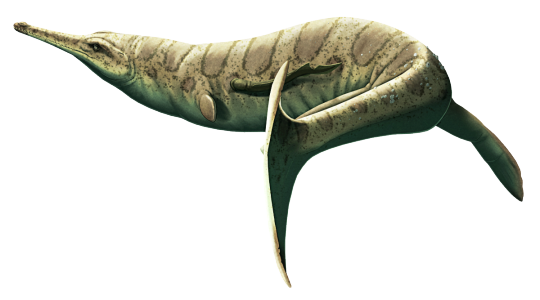
Metriorhynchids were a group of fully marine crocodyliforms known from the mid-Jurassic to the early Cretaceous of Europe and the Americas. They were the most aquatic-adapted of all known archosaurs, with streamlined bodies, smooth scaleless skin, small front flippers, larger hind flippers, and shark-like tail flukes. They may also have been endothermic, and might even have given live birth at sea rather than laying eggs.
Rhacheosaurus gracilis here was a metriorhynchid that lived in warm shallow waters around what is now Germany during the late Jurassic, about 150 million years ago. Around 1.5m long (~5'), its long narrow snout lined with delicate pointed teeth suggests it fed on small soft-bodied prey, a niche partitioning specialization that allowed it to coexist with several other metriorhynchid species in the same habitat.
Unlike most other marine reptiles metriorhynchids didn't have particularly retracted nostrils, which may have had a limiting effect on their efficiency as sustained swimmers since higher-set nostrils make it much easier to breathe without having to lift the whole head above the surface. The lack of such an adaptation in this group may be due to their ancestors having a single nasal opening formed entirely within the premaxilla bones at the tip of the snout, uniquely limiting how far it could easily shift backwards – other marine reptiles had nostrils bound by the edges of multiple different bones, giving them much more flexibility to move the openings around.
(By the early Cretaceous a close relative of Rhacheosaurus did actually evolve nostrils bound by both the premaxilla and the maxilla, and appeared to have started more significant retraction, but unfortunately this only happened shortly before the group's extinction.)
Metriorhynchids also had well-developed salt glands in front of their eyes, but the large sinuses that accommodated these glands may have made their skulls ill-suited to deep diving, being more susceptible to serious damage from pressure changes and restricting their swimming to near-surface waters only.
Preserved skin impressions in some metriorhynchid fossils show several unusual "irregularities", including curl shapes, small bumps, and cratering. It's unknown what exactly caused these marks, but they may represent scarring from external parasites such as lampreys and barnacles.
———
NixIllustration.com | Tumblr | Patreon
References:
Andrade, Marco BD, and Mark T. Young. "High diversity of thalattosuchian crocodylians and the niche partition in the Solnhofen Sea." 56th Symposium of Vertebrate Palaeontology and Comparative Anatomy, 2008. https://svpca.org/years/2008_dublin/abstracts.pdf#page=14
Séon, Nicolas, et al. "Thermophysiologies of Jurassic marine crocodylomorphs inferred from the oxygen isotope composition of their tooth apatite." Philosophical Transactions of the Royal Society B 375.1793 (2020): 20190139. https://doi.org/10.1098/rstb.2019.0139
Spindler, Frederik. "Live Birth in a Jurassic Marine Crocodile." Abstracts of the 90th Annual Meeting of the Paläontologische Gesellschaft, 2019. https://www.palaeontologie.geowissenschaften.uni-muenchen.de/pdfs/palges2019_abstracts.pdf#page=141
Spindler, Frederik, et al. "The integument of pelagic crocodylomorphs (Thalattosuchia: Metriorhynchidae)" Palaeontologia Electronica 24.2 (2021): a25. https://doi.org/10.26879/1099
Young, Mark T., et al. "Convergent evolution and possible constraint in the posterodorsal retraction of the external nares in pelagic crocodylomorphs." Zoological Journal of the Linnean Society 189.2 (2020): 494-520. https://doi.org/10.1093/zoolinnean/zlaa021
Young, Mark T., et al. "Skull sinuses precluded extinct crocodile relatives from cetacean-style deep diving as they transitioned from land to sea." Royal Society Open Science 11.10 (2024): 241272. https://doi.org/10.1098/rsos.241272
Wikipedia contributors. “Metriorhynchidae” Wikipedia, 12 Nov. 2024, https://en.wikipedia.org/wiki/Metriorhynchidae
Wikipedia contributors. “Rhacheosaurus” Wikipedia, 02 Dec. 2024, https://en.wikipedia.org/wiki/Rhacheosaurus
#science illustration#paleontology#paleoart#palaeoblr#rhacheosaurus#metriorhynchidae#thalattosuchia#crocodyliformes#crocodylomorpha#pseudosuchia#archosaur#art#marine reptile#lamprey#barnacle#parasite
546 notes
·
View notes
Text

Do birds express their personalities through song?
Although birdsong can signal individual quality and personality, very few studies have explored the relationship between individual personality and song complexity, and none have investigated this in females. A recent paper in Royal Society Open Science from Flinders University fills that gap by studying superb fairy‑wrens (Malurus cyaneus), a species where both males and females learn complex songs.
Read the full paper in Royal Society Open Science:
https://royalsocietypublishing.org/doi/10.1098/rsos.241497
295 notes
·
View notes
Text
A reef that has been degraded—whether by coral bleaching or disease—can’t support the same diversity of species and has a much quieter, less rich soundscape.
But new research from Woods Hole Oceanographic Institution shows that sound could potentially be a vital tool in the effort to restore coral reefs.
A healthy coral reef is noisy, full of the croaks, purrs, and grunts of various fishes and the crackling of snapping shrimp. Scientists believe that coral larvae use this symphony of sounds to help them determine where they should live and grow.
So, replaying healthy reef sounds can encourage new life in damaged or degraded reefs.
In a paper published last week in Royal Society Open Science, the Woods Hole researchers showed that broadcasting the soundscape of a healthy reef caused coral larvae to settle at significantly higher rates—up to seven times more often.
“What we’re showing is that you can actively induce coral settlement by playing sounds,” said Nadège Aoki, a doctoral candidate at WHOI and first author on the paper.
“You can go to a reef that is degraded in some way and add in the sounds of biological activity from a healthy reef, potentially helping this really important step in the coral life cycle.”
Corals are immobile as adults, so the larval stage is their only opportunity to select a good habitat. They swim or drift with the currents, seeking the right conditions to settle out of the water column and affix themselves to the seabed. Previous research has shown that chemical and light cues can influence that decision, but Aoki and her colleagues demonstrate that the soundscape also plays a major role in where corals settle.
The researchers ran the same experiment twice in the U.S. Virgin Islands in 2022. They collected larvae from Porites astreoides, a hardy species commonly known as mustard hill coral thanks to its lumpy shape and yellow color and distributed them in cups at three reefs along the southern coast of St. John. One of those reefs, Tektite, is relatively healthy. The other two, Cocoloba and Salt Pond, are more degraded with sparse coral cover and fewer fish.
At Salt Pond, Aoki and her colleagues installed an underwater speaker system and placed cups of larvae at distances of one, five, 10, and 30 meters from the speakers. They broadcast healthy reef sounds – recorded at Tektite in 2013 – for three nights. They set up similar installations at the other two reefs but didn’t play any sounds.
When they collected the cups, the researchers found that significantly more coral larvae had settled in the cups at Salt Pond than the other two reefs. On average, coral larvae settled at rates 1.7 times (and up to 7x) higher with the enriched sound environment.
The highest settlement rates were at five meters from the speakers, but even the cups placed 30 meters away had more larvae settling to the bottom than at Cocoloba and Tektite.
“The fact that settlement is consistently decreasing with distance from the speaker, when all else is kept constant, is particularly important because it shows that these changes are due to the added sound and not other factors,” said Aran Mooney, a marine biologist at WHOI and lead author on the paper.
“This gives us a new tool in the toolbox for potentially rebuilding a reef.”
Adding the audio is a process that would be relatively simple to implement, too.
“Replicating an acoustic environment is actually quite easy compared to replicating the reef chemical and microbial cues which also play a role in where corals choose to settle,” said Amy Apprill, a microbial ecologist at WHOI and a co-author on the paper.
“It appears to be one of the most scalable tools that can be applied to rebuild reefs, so we’re really excited about that potential.”"
-via Good News Network, March 17, 2024
#coral#coral reef#marine life#marine biology#conservation#ecology#environment#environmental news#endangered species#coral bleaching#virgin islands#science and technology#climate action#climate change#climate hope#soundscapes#sound therapy#good news#hope
2K notes
·
View notes
Text
Much like monkeys swinging from branch to branch, some parrots can swing through the trees with the greatest of ease, scientists have learned. But these colorful birds grip the branches with an unusual appendage: their beaks. Rosy-faced lovebirds can use their adaptable beaks as a third limb that supports them even as they swing like gibbons and spider monkeys. In research published Tuesday in Royal Society Open Science, scientists describe how the parrots hung underneath a 3D-printed “branch” and moved along by using their beaks and hind legs in tandem to alternately grasp, swing like a pendulum, let go and reattach themselves a few inches farther along.
Continue Reading.
1K notes
·
View notes
Text

Analysis Finds Many Medieval Books Bound With Seal Skin
A paper published in Royal Society Open Science found that many medieval book covers previously thought to be made from deer or boar skin were in fact made of sealskin. What do you think?
77 notes
·
View notes
Text

Excerpt from this story from Smithsonian Magazine:
An ambitious humpback whale is making waves in the marine biology community after researchers discovered he undertook an incredible 8,106-mile swim across the globe, likely to be the longest distance traveled for the species on record.
This odyssey was “truly impressive and unusual, even for this highly migratory species,” Ekaterina Kalashnikova, a whale researcher at the Bazaruto Center for Scientific Studies and lead author of a study published Wednesday in Royal Society Open Science that tracked the whale’s movements, tells Helen Briggs of the BBC.
Humpback whales are by no means sedentary. According to the study, they “undertake one of the longest known seasonal migrations of all mammals.” However, their migration routes tend to go “between latitudes,” traversing north and south to seek out feeding grounds in colder climates and breeding grounds near the tropics. Rarely do groups of humpback whales go from east to west, preventing them from encroaching on other whales’ territories.
That made it all the more surprising when Kalashnikova and her fellow researchers determined that the same humpback whale was spotted off the Pacific coast of Colombia in 2013 and 2017 before reaching Zanzibar, in the Indian Ocean, in 2022. The whale’s exact route between these endpoints is unknown, but he might have dipped south to Antarctica before tracking back up Africa’s eastern coast, which would extend his route even longer than 8,106 miles.
The discovery was enabled by a citizen science website called Happywhale.com that allows professional biologists and casual whale watchers alike to upload photographs of a whale’s tale, also known as its fluke. Distinct marks, patterns, pigments and scars all contribute to making each whale’s fluke one of a kind. Modified facial recognition software using artificial intelligence matches up distinct features that form a “flukeprint,” as distinct and recognizable as a human fingerprint or face.
62 notes
·
View notes
Text

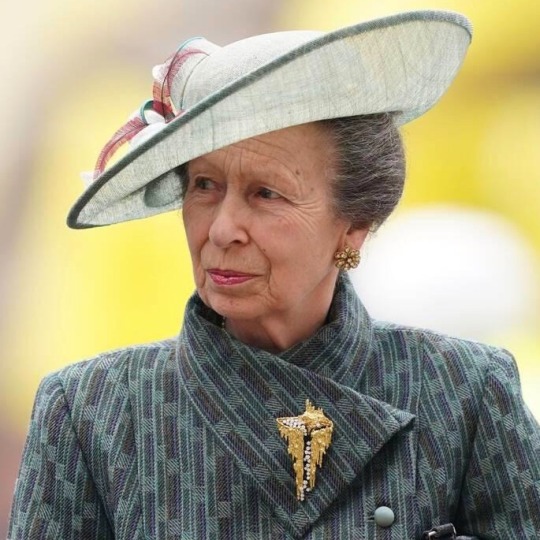
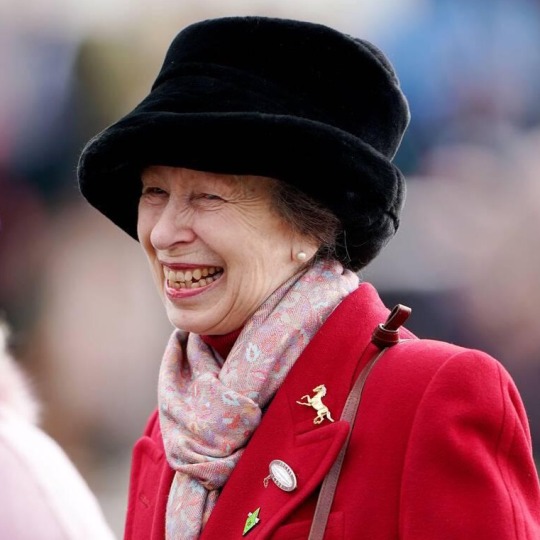
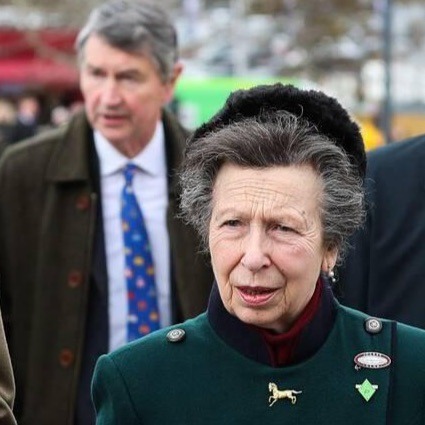

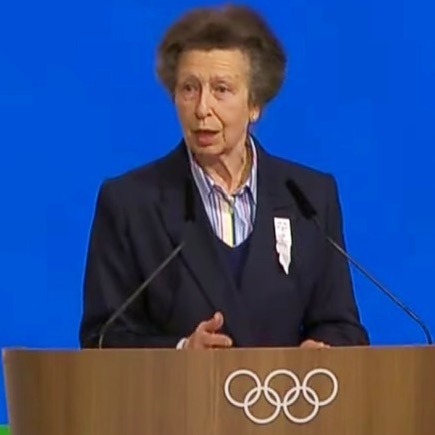


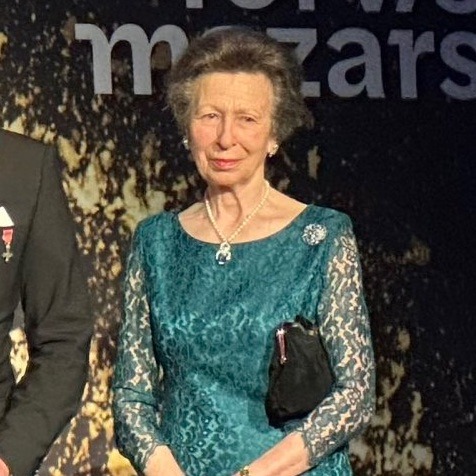
The Princess Royals Official Engagements in March 2025
03/03 Opened Minchinhampton Surgery in Minchinhampton near Stroud. 🩻👩⚕️
04/03 unofficial Sir Tim, as President of Kent Cricket Club, attended a memorial service at Canterbury Cathedral for former England spin bowler Derek Underwood. 🏏🤍
On behalf of The King, held an Investiture at the Palace of Holyroodhouse. 🎖️🏴
Attended a Royal Warrant Holders Association Reception at the Palace of Holyroodhouse. 📜🍽️
05/03 unofficial The King was represented by Dame Sarah Troughton (His Majesty’s Lord-Lieutenant of Wiltshire) at the Service of Thanksgiving for the Life of Lieutenant General Sir Maurice Johnston (formerly Her late Majesty’s Lord-Lieutenant of Wiltshire), held at St John’s Church in Devizes. The Princess Royal was represented by Captain Sir Nicholas Wright RN. 🕊️
As Patron of Maritime UK, chaired a National Council Meeting at the offices of Gallagher, the Walbrook Building, in London. ⚓️💼
As Chancellor of the University of London, opened King’s College London’s new Engineering Building. 🦾🦿
As Patron of the Maritime Society and Sea Cadets, and Admiral of the Sea Cadet Corps, held a Reception at Buckingham Palace. ⚓️🫡
06/03 As President, this afternoon attended the National Equine Forum at the Institution of Mechanical Engineers in London. 🐎
As Grand Master of the Royal Victorian Order, attended Evensong and a Reception at The King’s Chapel of the Savoy in London. ⛪️
07/03 As Admiral and Patron, this morning visited the Royal Naval Sailing Association in Gosport. ⛵️
Opened the new Emergency Department at Queen Alexandra Hospital in Portsmouth. 🏥
As Patron of Maritime UK, attended a Coastal Powerhouse Summit Reception at Portsmouth International Port. 🔋
08/03 With Sir Tim As Patron of the Scottish Rugby Union, attended the International Rugby Match between Scotland and Wales at Murrayfield Stadium in Edinburgh. 🏴🏴🏉
As Patron of Scottish Garden City Housing Society Limited, attended the 110th Anniversary Reception at Edinburgh Castle.🏡🥂
10/03 As Patron of the Canal Museum Trust, opened the “Building Britain’s Canals” Temporary Exhibition at the London Canal Museum. 💦🛶
Alongside The King and Queen, The Prince and Princess of Wales and The Duke and Duchess of Gloucester attended the Commonwealth Day Service of Celebration in Westminster Abbey. 🌍⛪️
11/03 As Past Master of the Worshipful Company of Butchers, attended the Annual City Food and Drink Lecture at Guildhall in London. 🍝🍷✍️
13/03 Unofficial Attended St Patrick’s Thursday of Cheltenham Races. ☘️🏇🏼
14/03 With Sir Tim Attended Gold Cup Friday of Cheltenham Races. 🏆🏇🏼
15/03 With Sir Tim As Patron of the Scottish Rugby Union, attended the International Rugby Match between France and Scotland at Stade de France, Paris. 🇫🇷🏴🏉
17/03 As Patron of Save the Children UK, attended the 30th Anniversary International Financial Review Annual Awards Dinner at the Grosvenor House Hotel in London. 🍽️
Unofficial As Chair of the Board of Trustees of the Science Museum, Sir Tim attended the Premiere of the Thinking Game and presented Science Museum Fellowship awards. 🎬🧬
18/03 Unofficial Departed from Heathrow Airport and arrived at Athens International Airport. 🇬🇧✈️🇬🇷
19/03 As Member of the International Olympic Committee, and Chairman of the Members Election Commission, attended day one of the International Olympic Committee Session at the Romanos in Costa Navarino, Greece. 🇬🇷
20/03 As Member of the International Olympic Committee, and Chairman of the Members Election Commission, attended day two of the International Olympic Committee Session at the Romanos in Costa Navarino, Greece. 🇬🇷
21/03 As Member of the International Olympic Committee, and Chairman of the International Olympic Committee Members Election Commission, attended day three of the International Olympic Committee Session at the House of Events, the Romanos Hotel in Costa Navarino, Greece. 🇬🇷
Unofficial Departed from Greece and arrived back at RAF Brize Norton. 🇬🇷✈️🇬🇧
24/03 As President of the Royal Society for the Encouragement of Arts, Manufactures and Commerce, attended the President’s Panel Discussion and Dinner. 🍽️
25/03 Joined by the King, As Patron of the Butler Trust, held the Annual Awards Ceremony at St James’s Palace, followed by a Reception.
26/03 As Patron of the Royal College of Emergency Medicine, attended the Spring Conference at Birmingham Repertory Theatre. 💊
As Colonel-in-Chief of The Royal Corps of Signals, inspected 22 Signal Regiment on public duties at St James’s Palace. 🫡
With Sir Tim As President of the Royal Commission for the Exhibition of 1851, attended a Presidential Dinner at Fishmongers’ Hall in London. 🎪🍽️
27/03 On behalf of The King, held an Investiture at Buckingham Palace. 🎖️
As Colonel of The Blues and Royals (Royal Horse Guards and 1st Dragoons), attended a Service of Thanksgiving for the new Organ at the Guards’ Chapel, Wellington Barracks, London. ⛪️🎹
As Patron of the British Quality Foundation, this attended the United Kingdom Awards Ceremony and Dinner at Wembley Stadium. 🏟️
28/03 On behalf of The King, held an Investiture at Buckingham Palace. 🎖️
Total official engagements for Anne in January: 34
2025 total: 97
Total official engagements accompanied/represented by Tim in January: 4
2025 total: 4
#busy lady 🫡#princess anne#princess royal#tim laurence#timothy laurence#aimees unofficial engagement count 2025#march 2025
33 notes
·
View notes
Text
Lauded Dutch Golden Age Painter Rachel Ruysch Gets Her First Major Survey in the U.S.
by Kate Mothes - Colossal, March 11, 2025
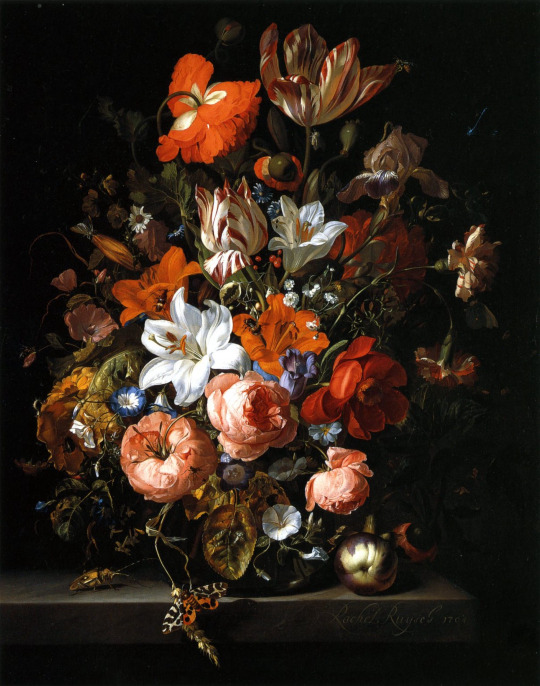
“Flowers in a Glass Vase” (1704), oil on canvas, 33 × 26 3/8 inches. Image courtesy of Detroit Institute of Arts.
Many of us are familiar with titans of the Dutch Golden Age like Frans Hals, Johannes Vermeer, Rembrandt, Jan Steen, and more. Yet fewer of us have probably heard of Rachel Ruysch (1664-1750), renowned during her lifetime for her original style but under-acknowledged through the centuries in the canon of Western art history.
Co-organized by the Toledo Museum of Art, the Museum of Fine Arts, Boston, and the Alte Pinakothek, Munich, the first major U.S. exhibition of the artist’s work, Rachel Ruysch: Nature into Art, introduces audiences to the breadth of her remarkable paintings.
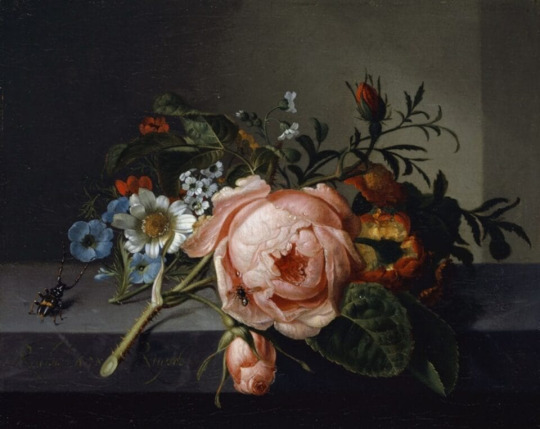
“Posy of Flowers, with a Beetle, on a Stone Ledge” (1741), oil on canvas, 7 7/8 × 9 5/8 inches. Image courtesy of Kunstmuseum Basel
During her seven-decade career, Ruysch was the first woman admitted to the Confrerie Pictura, The Hague painters’ society, and she was appointed court painter in Düsseldorf to Johann Wilhelm, Elector Palatine. She rose to become one of the highest-paid artists of her day. In a foreword for the exhibition catalog, the directors explain that “Ruysch achieved fame across Europe in her lifetime, but her oeuvre was little studied by art historians in subsequent centuries. She has never been the subject of a major exhibition—until now.”
Art historians consider Ruysch to be among the most talented still life artists of the era, and by the time she died at 86, she had produced hundreds of paintings. Nature into Art includes more than 90 international loans, including 48 of her most significant works.
The artist was born in The Hague, The Netherlands, to parents with backgrounds in science and design. Her father was a professor of botany and anatomy, and her mother was the daughter of an architect. The artist began painting when she was around 15, copying flower and insect specimens from her father’s collection.
As her artistic faculty grew, Ruysch taught her father and her sister Anna how to paint. She merged modern scientific observation with an incredible aptitude for capturing light, composition, and form, and she typically dated her paintings when she signed them, giving art historians a clear record of stylistic shifts and subject matter over time.
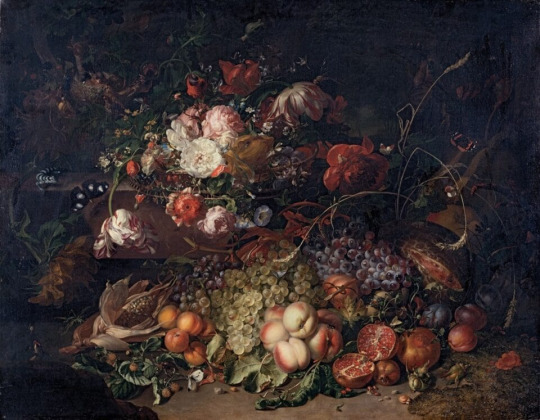
“Flowers and Fruit in a Forest” (1714), oil on canvas, 38 × 48 1/2 inches. Image courtesy of Städtische Kunstsammlungen & Museen Augsburg
Ruysch’s success during her lifetime is attributed to both her unmistakable talent and the 17th-century Dutch fondness for flowers and gardening. Still life paintings of floral arrangements and tables heaping with food highlighted the beauty of nature and the gifts of plenty. The vanitas genre also sprung from the style, interpreting memento mori, Latin for “remember you must die,” into subtle, well-versed visual cues.
Motifs like skulls, insects, rotting fruit, or wilting flowers were symbolic reminders of the futility of pleasure, power, or wealth after death. For example, in Ruysch’s “Posy of Flowers, with a Beetle, on a Stone Ledge,” beetles and flies crawl over a spray of peonies and wildflowers that will soon wilt, and water droplets signify purity and the fleetingness of life.
Nature into Art runs from April 12 to July 17 in Toledo, traveling on to Boston afterward, where it opens on August 23.
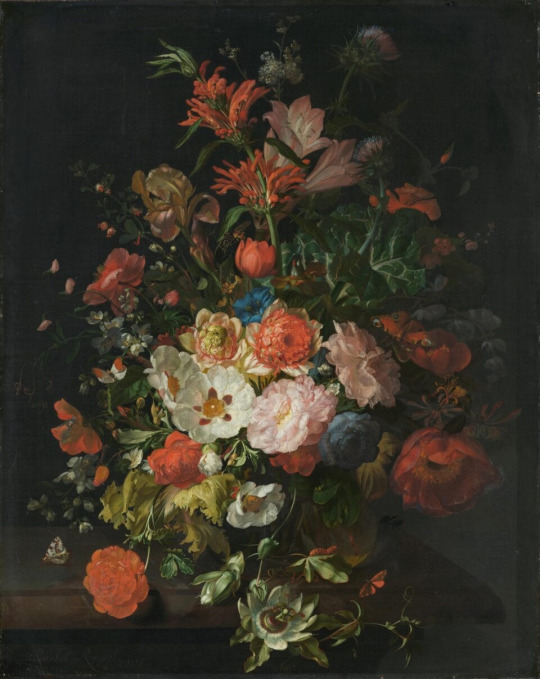
“Flowers” (1715), oil on canvas, 29 2/3 × 23 3/4 inches. Photo by Photo: Nicole Wilhelms, courtesy of Bayerische Staatsgemäldesammlungen—Alte Pinakothek Munich
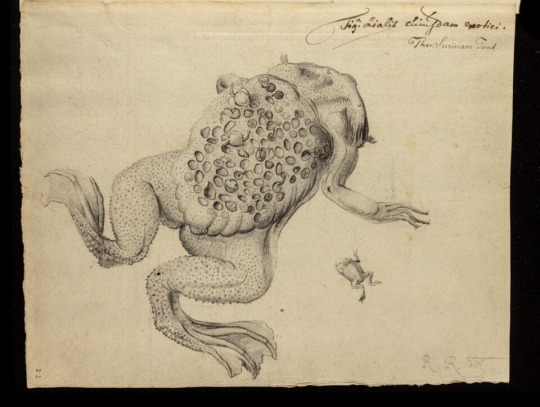
Illustration from ‘Observations of a Surinam Toad,’ graphite on paper, 8 x 11 in. Image © The Royal Society, London
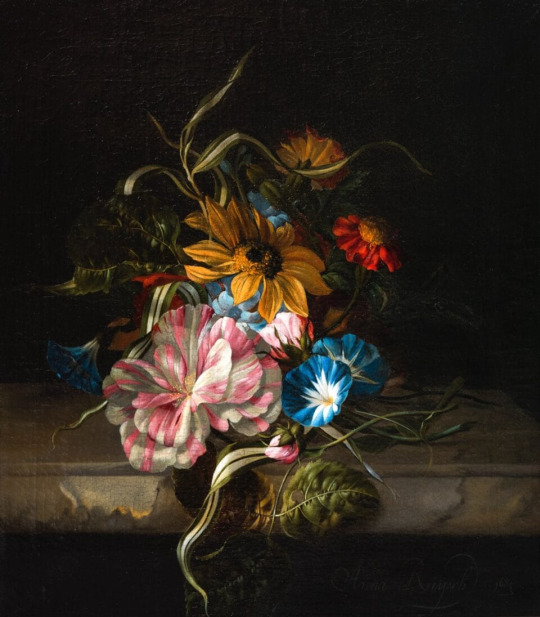
Anna Ruysch (Dutch, active from 1685, died after 1741), “A Still Life of Flowers on a Marble Table Ledge” (1685), oil on canvas, 13 × 11 3/4 inches. Photo by Erin Croxton, courtesy of a private collection and Birmingham Museum of Art
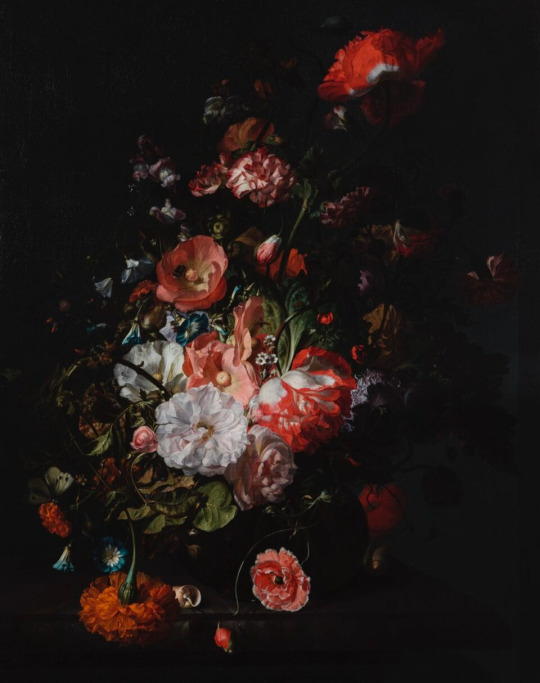
“Flower Still Life” (about 1716-20), oil on canvas, 29 3/4 × 23 7/8 inches. Image courtesy of Toledo Museum of Art
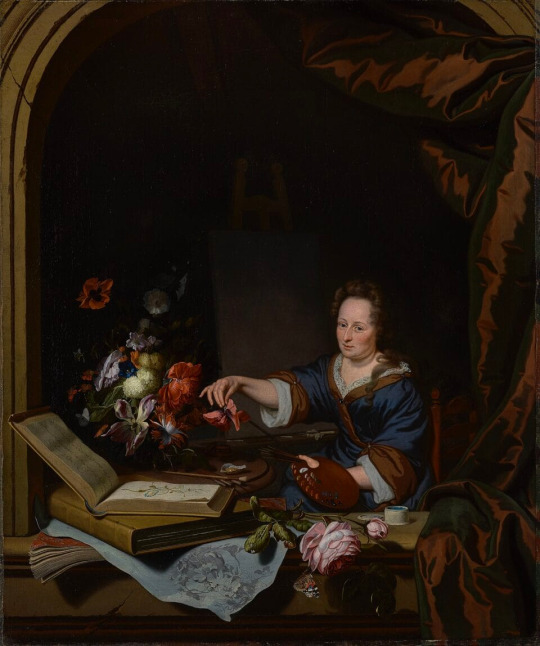
Rachel Ruysch and Michiel van Musscher (Dutch, 1645–1705), “Rachel Ruysch (1664–1750)” (1692), oil on canvas, 30 × 25 inches. Image courtesy of the Metropolitan Museum of Art
#oil painting#still life#Rachel Ruysch#Rachel Ruysch: Nature into Art#Colossal#March 2025#trypophobia#bügge art
39 notes
·
View notes
Text

Raccoons show surprising problem-solving abilities in urban backyards
Find could lead to new ways to manage “trash pandas”
Great Basin was burning the midnight oil on a chilly fall evening in 2016 when he made his move. Slinking out of the shadows in Laramie, Wyoming, the raccoon approached what looked like a metal filing cabinet lying on its side. He could smell a mix of dog kibble and sardines within, but 12 latched narrow doors blocked his entry. Making matters worse, a fellow raccoon had beaten him there. So Great Basin jumped on top of the cabinet and began to fiddle with the latches upside down. He quickly opened one of the doors, securing the treats and filling his belly. Humans have long regarded raccoons—renowned for their ability to jimmy their way into locked garbage cans and enter seemingly impassable attics—with a mixture of awe and scorn. But outside of the lab, researchers have little scientific sense of how clever these “trash pandas” really are. A study published today in the Proceedings of the Royal Society B: Biological Sciences may change that...
Read more: https://www.science.org/content/article/raccoons-show-surprising-problem-solving-abilities-urban-backyards
80 notes
·
View notes
Text
An international study has revealed spruce trees not only respond to a solar eclipse but actively anticipate it by synchronizing their bioelectrical signals hours in advance into a cohesive, forest-wide phenomenon. The discovery, published in the journal Royal Society Open Science, shows older trees exhibit a more pronounced early response, suggesting these ancient sentinels retain decades of environmental memory and may use it to inform younger trees of impending events. This study adds to the emerging evidence that plants are active, communicative participants in their ecosystems, capable of complex, coordinated behaviors akin to those seen in animal groups. The lead authors are Professor Alessandro Chiolerio of the Italian Institute of Technology and University of the West of England, and Professor Monica Gagliano from Southern Cross University, Australia. "This study illustrates the anticipatory and synchronized responses we observed are key to understanding how forests communicate and adapt, revealing a new layer of complexity in plant behavior," said Professor Gagliano. "Basically, we are watching the famous 'wood wide web' in action."
continue reading
That they know when an eclipse is going to happen … I'm speechless.
#italy#plant research#plant communication#spruce forest#in sync reaction#eclipse#old growth trees#science#nature
20 notes
·
View notes
Text
What if humans were raised by chickens and eventually consumed ???
Joey Chestnut

Et si les humains étaient élevés par des poulets et finalement consommés ???

Avec plus de 20 milliards d’individus, le poulet constitue l’espèce la plus importante parmi les vertébrés. Nous habitons une planète de poulets. Ces animaux élevés pour leur viande pèsent à eux seuls trois fois plus que l’ensemble des oiseaux sauvages réunis. Et, au-delà même des oiseaux, il s’agit de l’espèce vertébrée la plus répandue sur Terre : elle compte 23 milliards d’individus vivants et constitue la viande la plus consommée dans le monde. Elle est ainsi devenue un symbole frappant de l’anthropocène – cette nouvelle ère géologique caractérisée par l’impact écrasant des humains sur les processus géologiques terrestres. Le poulet tel que nous le connaissons a tellement évolué au regard de ses ancêtres, que ses os deviendront sans doute des fossiles de ce temps où les humains régnaient sur la planète. Dans une récente étude publiée dans Royal Society Open Science, nous avons comparé les os des poulets contemporains à ceux de leurs ancêtres de l’époque pré-romaine. Nos poulets actuels apparaissent radicalement différents : ils sont dotés d’un squelette surdimensionné, leur chimie cérébrale reflète l’homogénéité de leur régime alimentaire et la diversité génétique de l’espèce a significativement diminué. Le poulet actuel apparaît ainsi deux fois plus grand que le poulet médiéval. Le but de son élevage n’est autre qu’une prise de poids rapide.

Un poulet âgé de cinq semaines, à côté de son ancêtre (la poule rouge « de jungle ») âgée de six semaines. Bennett et al / Royal Society, Author provided
La vitesse de sa croissance s’est accélérée durant la seconde moitié du XXᵉ siècle : aujourd’hui, le poulet dit de chair grossit cinq fois plus vite que les poulets des années 1950. Ils sont par conséquent mûrs pour l’abattage à seulement cinq ou six semaines. La preuve de cette croissance extraordinaire est inscrite dans leurs os, qui apparaissent moins denses et souvent déformés. Il est poignant de constater que ces oiseaux ne survivraient pas s’ils sortaient de l’élevage industriel. Du fait de leur corps énorme, beaucoup d’oiseaux meurent de problèmes cardiaques ou respiratoires lorsqu’ils vivent un mois de plus.
21 notes
·
View notes
Text
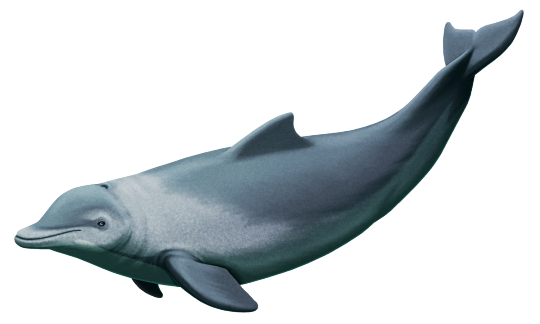
Albireonids were an early branch of the delphinoid whales, with their closest living relatives being modern oceanic dolphins, narwhals and belugas, and porpoises. Known from temperate latitudes of the North Pacific Ocean between the late Miocene and the late Pliocene, about 9-2.5 million years ago, their fossil remains are very rare in coastal deposits and they seem to have primarily been offshore open ocean animals.
Albireo whistleri is the best known member of this family, represented by a near-complete skeleton from what is now Isla de Cedros in Baja California, Mexico, dating to the late Miocene between about 8 and 6 million years ago. It was a rather small dolphin, around 2.5m long (~8'2"), with a stocky body, fairly broad flippers, and skull anatomy with some convergent similarities with the modern Dall's porpoise.
Interestingly these dolphins also seem to have frequently had pathological neck vertebrae, with both Albireo whisteri and the younger species Albireo savagei from California, USA, showing unusually asymmetrical atlas bones – but on opposite sides to each other. This might be due to illness or injury earlier in life, or possibly be evidence of some sort of "handedness" with individuals preferring to perform some actions more with one side of their body than the other.
———
NixIllustration.com | Tumblr | Patreon
References:
"Albireonidae." Paleobiology Database, https://paleobiodb.org/classic/checkTaxonInfo?taxon_no=42961
Barnes, Lawrence G. Fossil odontocetes (Mammalia: Cetacea) from the Almejas Formation, Isla Cedros, Mexico. University of California, Museum of Paleontology, 1984. https://books.google.com/books?id=rxyydMGWGqgC
Barnes, Lawrence G. "Miocene and Pliocene Albireonidae (Cetacea, Odontoceti), rare and unusual fossil dolphins from the eastern North Pacific Ocean." Natural History Museum of Los Angeles County Science Series 41 (2008): 99-152. https://www.researchgate.net/profile/Xiaoming-Wang-43/publication/252086599_Geology_and_Vertebrate_Paleontology_of_Western_and_Southern_North_America/links/5625900908ae4d9e5c4bb863/Geology-and-Vertebrate-Paleontology-of-Western-and-Southern-North-America.pdf#page=105
Gillet, Amandine, Bruno Frédérich, and Eric Parmentier. "Divergent evolutionary morphology of the axial skeleton as a potential key innovation in modern cetaceans." Proceedings of the Royal Society B 286.1916 (2019): 20191771. https://doi.org/10.1098/rspb.2019.1771
Thomas, Howell W., et al. "Examples of paleopathologies in some fossil Cetacea from the North Pacific realm." Natural History Museum of Los Angeles County Science Series 41 (2008): 153-179. https://www.researchgate.net/profile/Xiaoming-Wang-43/publication/252086599_Geology_and_Vertebrate_Paleontology_of_Western_and_Southern_North_America/links/5625900908ae4d9e5c4bb863/Geology-and-Vertebrate-Paleontology-of-Western-and-Southern-North-America.pdf#page=159
#science illustration#paleontology#paleoart#palaeoblr#albireo#albireonidae#delphinoidea#dolphin#odontoceti#cetacean#whale#artiodactyla#ungulate#mammal#marine mammals#art#paleopathology
270 notes
·
View notes
Text

Hundreds of snake species get a new origin story
Elapoid snakes, including cobras, mambas and sea snakes, may have evolved in Asia, not Africa
The ancestors of cobras and related snakes first emerged in Asia roughly 35 million years ago. Many researchers thought the Elapoidea superfamily of snakes evolved in Africa before slithering their way across the globe. But new genetic evidence points to the continent next door to Africa, researchers report August 7 in Royal Society Open Science. The over 700 species of elapoid snakes are extremely diverse, including both highly venomous reptiles like mambas and sea snakes and many nonvenomous species. They’re found in subtropical and tropical regions around the world, in rainforests, deserts and oceans. But the elapoids have long had a murky origin story, says Jeff Weinell, an evolutionary biologist at the American Museum of Natural History in New York City...
Read more: https://www.sciencenews.org/article/snake-species-origin-asia-not-africa
157 notes
·
View notes
Text
Ancient frog relatives survived the aftermath of the largest mass extinction of species by feeding on freshwater prey that evaded terrestrial predators, University of Bristol academics have found. In the study, "The ecology and geography of temnospondyl recovery after the Permian—Triassic mass extinction" published in the journal Royal Society Open Science, their findings suggest the amphibians' success lay in their generalist feeding ecology, enabling them to feed on a wide variety of prey despite the array of environmental changes happening all around them throughout the Triassic.
Continue Reading.
82 notes
·
View notes